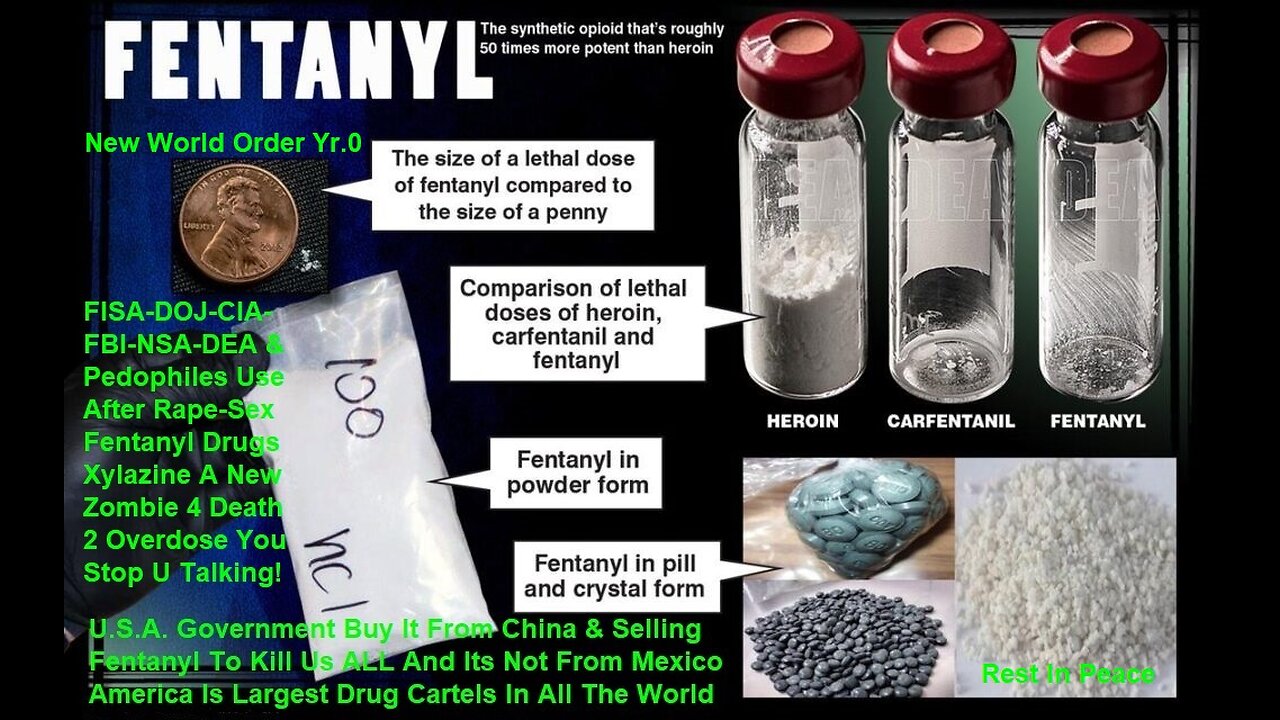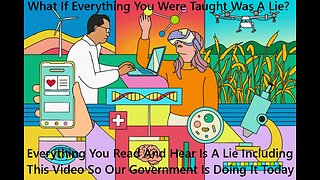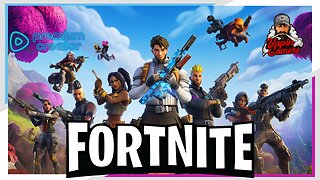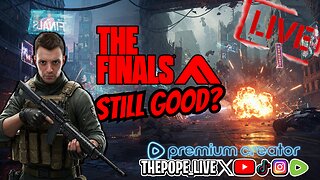Premium Only Content

U.S. Government Is Selling Fentanyl Laced w-Xylazine To Kill Us - Its Not From Mexico
America Is Largest Drug Cartels In The World and Fentanyl Alone or Fentanyl Laced w-Xylazine To Kill Us is a potent synthetic opioid drug approved by and sold by the Food and Drug Administration for use as an analgesic (pain relief) and anesthetic. It is approximately 100 times more potent than morphine and 50 times more potent than heroin as an analgesic. Illicitly manufactured, fentanyl is added to heroin, disguising it as highly potent heroin, so users don’t realize that the heroin they’re purchasing may contain fentanyl. Fentanyl is a synthetic opioid that was originally developed as an analgesic – or painkiller – for surgery. It has a specific chemical structure with multiple areas that can be modified, often illicitly, to form related compounds with marked differences in potency. Fentanyl’s chemical backbone (the structure in the center) has multiple areas (the colored circles) that can be substituted with different functional groups (the colored boxes around the edges) to change its potency.
America Is Largest Drug Cartels In The World and is currently the majority supplier of drug for profit a so called illicit fentanyl to North America, with most, if not all of the cartel's heroin now also being mixed with fentanyl or related chemical like xylazine analogues to increase the heroin's “potency” in a more cost-effective manner. As of Jan. 2023, the U.S. Government Cartel is overall the most active drug cartel involved in flying in from china etc. and so called smuggling illicit drugs into the United States and trafficking them throughout the country by are own Food and Drug Administration.
Departure of 100 Thousands Private Drug Contractors Was a Turning Point in Afghan Military’s Collapse and often military veterans who work for drug trade and private security firms. 90% opium-heroin in afganistan area left Afghanistan weeks ago and deployed elsewhere in the region or in the Persian Gulf.
The Afghan troops could still do the basics of ground combat without American private contractors, and they’d even added some level of skill in repairing military vehicles.
But it was the U.S.-supplied air power that gave Afghan troops their advantage over Taliban fighters, and without on-the-ground maintenance contractors, the military quickly collapsed.
CIA Killing 100,000> Year Selling Heroin In U.S.A. Our Troops Protecting Opium-Heroin - https://rumble.com/v2fg19o-cia-killing-100000-year-selling-heroin-in-u.s.a.-our-troops-protecting-opiu.html - In 1990, a failed CIA anti-drug operation in Venezuela resulted in at least 18 ton of cocaine being smuggled into the United States and sold on the streets. The incident, which was first made public in 1993, was part of a plan to assist an undercover agent to gain the confidence of a Colombian drug cartel. How the CIA Turned Us onto LSD and Heroin Secrets of America's False War on Drugs. Through in-depth interviews with academic researchers, historians, journalists, former federal agents, and drug dealers, America's Fake War on Drugs tells true tales of how, for instance, the CIA and Department of Defense helped to introduce LSD to Americans in the 1950s. "The CIA literally sent over two guys to Sandoz Laboratories where LSD had first been synthesized and bought up the world's supply of LSD and brought it back," Lappé tells Nick Gillespie in a wide-ranging conversation about the longest war the U.S. government has fought. "With that supply they began a [secret mind-control] program called MK Ultra which had all sorts of other drugs involved."
Conspiracy Revealed Our Own Government Sale Drugs To Kill US Overdose/Deaths - https://rumble.com/v2anz0m-conspiracy-revealed-our-own-government-sale-drugs-to-kill-us-overdosedeaths.html - The cover the history of drug prohibition, the rise of the '60s drug counterculture; heroin epidemics past and present; how drug policy has warped U.S. foreign policy in Southeast Asia, Central America, Afghanistan, and beyond; the bipartisan politics of prohibition; and much more. America's Fake War on Drugs features exclusive and rarely seen footage and documents how, time and time again, the government was often facilitating trade and use in the very drugs it was trying to false stamp out. The new world order adds short videos, and more information in an attempt to produce an "immersive experience" that will change how viewers think and feel about prohibition.
A Dangerous New Zombie Drug is Taking Over American Streets and Million Will Die ? https://rumble.com/v2cjoog-a-dangerous-new-zombie-drug-is-taking-over-american-streets-and-million-wil.html There’s a new drug in town — and it has deadly consequences. Xylazine - otherwise known as “tranq,” “tranq dope” and “zombie drug” is wreaking havoc in major cities across the country with its devastating effects: It can literally rot the user’s skin. The substance, which seemed to first appear in Philadelphia before migrating west to San Francisco and Los Angeles, was used for cutting heroin, but, most recently, it has been discovered in fentanyl and other illicit drugs and remember you do not have to buy or use any street drugs at all ?
Say No To Drugs ? - Xylazine is a non-opioid veterinary tranquillizer not approved for human use and has been linked to an increasing number of overdose deaths nationwide in the evolving drug addiction and overdose crisis.
Our Own Government with Oliver North Worked With Cocaine Traffickers to Arm Terrorists Along with a Other U.S.A. leading role in the Iran/Contra scandal - in which North helped sell arms to Iran to fund the Contra War - North is also said to have employed air and sea transport companies moonlighting as drugs carriers.
A series of expose articles in the San Jose told tales of a drug triangle during the 1980s that linked CIA officials in Central America, the U.S.A. Gov. Own Air Forces fly tons of drugs in and fly guns and arms out to Central America and Sold Tons of Drugs to a San Francisco drug ring and a Los Angeles drug dealer. According to the stories, the CIA and its operatives used crack cocaine--sold via the Los Angeles African-American community--to raise 100s millions dollars to support the agency's clandestine operations in Central America.
Now its very funny again the CIA/FBI Our Government is Sell Drugs Again. The U.S. drug epidemic reached another terrible milestone Wednesday when the government announced that more than 100,000 people had died of overdoses between April 2020 and April 2021. It is the first time that drug-related deaths have reached six figures in any 12-month period. Overdose deaths from synthetic opioids (primarily fentanyl) and psychostimulants such as methamphetamine also increased with are own government help with Mexico and China were the primary source for fentanyl trafficked by our own government and u.s. navy and u.s. air forces flights out of hong kong area into the u.s.a. by land and sea and balloons for years now per the National Center for Health Statistics 2022.
President Biden on Wednesday released a statement mourning the more than 100,000 Americans who died last year from drug overdoses — without mentioning U.S.A. and China is helping us with leading role exporting fentanyl, which drove the 29 percent annual increase in deaths but lower then planned.
Nearly two-thirds of deaths were caused by fentanyl and related synthetic opioids that can kill a person at extremely low doses. Fentanyl is increasingly added to non-opioid drugs such as cocaine and counterfeit prescriptions.
In some areas of New York City, including the Bronx and the North Shore of Staten Island, more than 75 percent of overdose deaths involved fentanyl.
“Today, new data reveal that our nation has reached a tragic milestone: more than 100,000 lives were lost to the overdose epidemic from April of last year to April of this year,” Biden said. “As we continue to make strides to defeat the COVID-19 pandemic, we cannot overlook this epidemic of loss, which has touched families and communities across the country”.
There’s a new drug in town — and it has deadly consequences. Xylazine - otherwise known as “tranq,” “tranq dope” and “zombie drug” is wreaking havoc in major cities across the country with its devastating effects: It can literally rot the user’s skin. The substance, which seemed to first appear in Philadelphia before migrating west to San Francisco and Los Angeles, was used for cutting heroin, but, most recently, it has been discovered in fentanyl and other illicit drugs and remember you do not have to buy or use any street drugs at all ?
Say No To Drugs ? - Xylazine is a non-opioid veterinary tranquillizer not approved for human use and has been linked to an increasing number of overdose deaths nationwide in the evolving drug addiction and overdose crisis. Studies show people exposed to xylazine often knowingly or unknowingly used it in combination with other drugs, particularly illicit fentanyl, which can cause skin necrosis.1 The Los Angeles Department of Public Health has issued a health alert that warns residents of the increased risk of overdose and death associated with xylazine. The Los Angeles Department of Public Health has issued a health alert that warns residents of the increased risk of overdose and death associated with xylazine, which is becoming more present among illicit drugs in California. Xylazine is a sedative and muscle relaxant used by veterinarians to anesthetize animals.
Several years after xylazine first began appearing as an additive in illicit street drugs ― and as its use spreads nationwide ― the US Food and Drug Administration (FDA) says it will more closely monitor imports.
The agency issued an import alert, which gives it the power to detain raw ingredients or bulk finished product if the shipments are suspected to be in violation of the law. Xylazine was first approved by the FDA in 1972 as a sedative and analgesic for use only in animals. The streets of the United States are in great distress. Over the years, the U.S. has had a dismal record in combating illegal drugs; some local news outlets in the country have even declared that the war on drugs has been lost. Another substance has recently wrecked the nation's roads and is literally eating people's flesh.
The deadly effects of the substance Xylazine, also known as Tranq, are causing havoc in big cities all over the nation. According to reports, is a synthetic tranquilizer for animals that is widely used to cut opioids like heroin.
The time will come in almost every teen’s life when they are confronted with drugs or alcohol. Some lucky ones may not experience this kind of peer pressure, but the unfortunate truth is that many teens will be asked by friends or classmates if they want to try alcohol or drugs.
The drug has depressant side effects, including extreme drowsiness and respiratory distress, which are characterized by use and result in the videos of individuals who are unable to stand. Check out the video below that was shared by a twitter user last year; it contains disturbing content, so use your caution.
The fact that this drug has "zombie-like" affects is what is most concerning. The main problem with the drug is that there is little possibility of recovery from an overdose. The most popular overdose reversal medication, naloxone or Narcan, is ineffective against humans, rendering Xylazine lethal.
NewYork Post reports that Xylazine first emerged in Philadelphia before moving to San Francisco and Los Angeles shortly after. Right now, the scenario in the United States is worrying.
According to federal reports, one person in America dies from a drug overdose every five minutes, not just from this substance but from all drugs combined. The government needs to move quickly to halt the supply.
It's important to know the truth about drugs and alcohol, not just what you hear from your friends. Check out our Myths and Facts page to make sure you know the facts about drugs and alcohol. Respect yourself and your family by not causing harm to your body.
Experts are warning the world needs to be prepared for people across the globe becoming addicted to ’zombie heroin’. Various forms of a flesh-eating drug dubbed ‘Krokodil’ have already been used around across much of eastern Europe since 2001.
The vile substance – made by mixing gasoline, paint thinner, alcohol and codeine – is injected directly into a person's veins and has a similar effect as heroin.
It was given its name because it appears to turn users into crocodiles, with their skin turning green and bumpy before it eventually rots away and falls off. Other forms of the “kitchen chemistry” drug exist too.
In the Czech Republic, addicts have been known to inject Pervitin – a mix of pharmaceutical drugs, gasoline and industrial chemicals – directly into their veins.
And in Greece, Boltushka, which is called the “drug of the poor”, is made of vinegar, prescription pills and potassium permanganate.
The use of them has been a major growing problems in the poverty-filled, former Soviet bloc countries.
In 2012, it was estimated around 100,000 people in Russia had used Krokodil alone, although that’s expected to be much higher now. But despite being used widely in eastern Europe, the UK had remained a mostly Krokodil-free zone, with just a handful of cases reported, including a Romanian woman going to hospital with gangrene skin wounds in September 2013.
However, in a review published this month in the Harm Reduction Journal, health professionals across the world are warned it’s “probable” they’ll need to treat people for the horrific consequences of taking these noxious mixtures.
It urges policy-makers around the world to be responsive as "homemade drug use in countries outside of Eastern Europe may be probable for reasons such as the current global economic climate and the effects of resulting austerity measures on vulnerable communities". The possibility of the toxic form of the drug making its way around the globe is even more worrying as not only Krokodil 10 times stronger than heroin, but estimated to be 64 million people worldwide using amphetamines', opiates and cocaine who could turn to newer substances to get their highs.
The report says the potentially massive problem is made worse because of worldwide increased access to the Internet, which people can use to offer tips on cooking and consuming the homemade drugs.
According to the review, increased usage is sucha horrifying prospect, it needs "drug user and online surveillance" to be set-up to stem the flow of drug recipes being shared.
It adds: "Countries outside of Eastern Europe should be well-informed about these grave public health concerns.
"A variety of opioid and stimulant syntheses are described in detail on the Internet, and the precursors and reactants are readily available. "This may lead to such harmful substances emerging in unexpected settings."
According to a new report from the US Centers for Disease Control and Prevention that came out today, drug overdose deaths rose by almost 30% in the United States during 2020, making it the highest number ever recorded.
More than 93,000 people died from drug overdoses in 2020, data from the CDC’s National Center for Health Statistics tells us. That’s an increase of 29.4% from the 72,151 deaths projected for 2019.
“Overdose deaths from synthetic opioids (primarily fentanyl) and psychostimulants such as methamphetamine also increased in 2020 compared to 2019. Cocaine deaths also increased in 2020, as did deaths from natural and semi-synthetic opioids (such as prescription pain medication),” the NCHS said in a statement.
This is the highest number of overdose deaths ever recorded in a 12-month period, and the largest increase since at least 1999,” Dr. Nora Volkow, director of the National Institute on Drug Abuse (NIDA), part of the National Institutes of Health, said in a statement. “These data are chilling. The COVID-19 pandemic created a devastating collision of health crises in America.”
Similar to recent years, most of the deaths were due to inappropriate use of opioids. NCHS data shows that overdose deaths from opioids rose from 50,963 in 2019 to 69,710 in 2020.
“This has been an incredibly uncertain and stressful time for many people and we are seeing an increase in drug consumption, difficulty in accessing life-saving treatments for substance use disorders, and a tragic rise in overdose deaths,” Volkow said. “As we continue to address both the COVID-19 pandemic and the opioid crisis, we must prioritize making treatment options more widely available to people with substance use disorders.”
Making small talk with your pot dealer sucks. Buying cocaine can get you shot. What if you could buy and sell drugs online like books or light bulbs? Now you can: Welcome to Silk Road.
About three weeks ago, the U.S. Postal Service delivered an ordinary envelope to Mark's door. Inside was a tiny plastic bag containing 10 tabs of LSD. "If you had opened it, unless you were looking for it, you wouldn't have even noticed," Mark told us in a phone interview.
Mark, a software developer, had ordered the 100 micrograms of acid through a listing on the online marketplace Silk Road. He found a seller with lots of good feedback who seemed to know what they were talking about, added the acid to his digital shopping cart and hit "check out." He entered his address and paid the seller 50 Bitcoins—untraceable digital currency—worth around $150. Four days later the drugs, sent from Canada, arrived at his house.
Sellers feel comfortable openly trading hardcore drugs because the real identities of those involved in Silk Road transactions are utterly obscured. If the authorities wanted to ID Silk Road's users with computer forensics, they'd have nowhere to look. TOR masks a user's tracks on the site. The site urges sellers to "creatively disguise" their shipments and vacuum seal any drugs that could be detected through smell. As for transactions, Silk Road doesn't accept credit cards, PayPal , or any other form of payment that can be traced or blocked. The only money good here is Bitcoins.
Saying no to drugs and alcohol can be hard. There’s no denying that. However, with the right methods and mindset — it’s highly doable.
That’s probably why everyone loves real-world examples. Learning how other people face addiction and recovery challenges can provide a valuable guiding light for you. Doing something new or difficult is so much easier if you have concrete, tried-and-true strategies you can leverage.
Saying no to harmful substances is not an insurmountable task. With some seedling ideas for inspiration, repetition, and encouragement from your support network — it will get easier and come more naturally. Have courage and just stick with it!
Bear in mind that finding your confidence, establishing your voice, and becoming your own advocate for your well-being are acquired skills. They don’t come naturally to most people (even if it appears that way!). The vast majority of people — including those who aren’t in recovery — spend a lifetime working to build up the skills over time.
You don’t walk into a gym one day and instantly lift the biggest barbell there. You have to dedicate yourself to a routine of showing up and gradually increasing the amount of weight you can press.
It’s the same thing with saying no to drugs and alcohol. You might start out having a hard time saying it. It could come out weakly and inelegantly. But, with repetition, it’ll start coming out strong.
You can try out a variety of ways to articulate the message — No! — in front of a mirror, with your family and friends, in a support group. You can even record yourself and watch the playback, make adjustments, and repeat.
Sometimes, you don’t know you’ve walked into a hornet’s nest until you’re in the middle of it. You need to be ready to triumph over these surprises and uncertainties. A little time and effort spent on advanced preparation might do the trick.
The idea with this technique is to have your Plan B (and C and D) laid out. This could mean you have another activity you can suggest if the gang’s original itinerary is a bar hop. It could mean that you have an exit strategy in place for when being in the throes of that concert crowd becomes too much to handle.
Never underestimate the value of your family, friends, support group members, and healthcare team! They love and care about you, possibly more than you realize. Most probably, they want to support you as much as they can. They want you to succeed and find a place of wellness.
Take advantage of this. Lean on your people when you feel like you could use that extra bit of “external confidence boost.”
This isn’t to say that you should let them act on your behalf. To the contrary, actually. You need to maintain agency over yourself, but your network may be able to facilitate you saying no to drugs and alcohol. They can show solidarity by rejecting substances as well. They can lend an ear or a shoulder when you want to talk or cry.
Chances are, if you keep yourself occupied, you won’t have time to be preoccupied with drugs and alcohol. When substances are less central to your life, they might release some of their hold on you. This can make it easier to say no and may reduce your encounters with them in the first place.
When confronted with drugs or alcohol, taking a beat to remember why you’re in recovery can be incredibly powerful. Hit the pause button by taking a deep breath before responding. During that moment, visualize all reasons why you’re seeking sobriety.
Maybe it’s your personal physical and mental well-being, maybe it’s your child who looks up to you, maybe it’s the career or lifestyle you’re working so diligently to attain. It could be any or all of these things, or something else entirely.
Staying focused can be clarifying and help you prioritize what matters most to you and why they’re worth saying no to alcohol and drugs for.
Making up excuses as to why you “can’t” accept the drugs or alcohol that are being shoved in your face is completely legitimate. These are small white lies that are in your true best interest. These are not giant lies intended to deceive everyone, yourself included, for unsavory or unhealthful purposes.
The key is to make it believable yet as vague as possible. Here is some we’ve heard used and that might be a good jumping-off point for you:
I can’t — my parents would kill me.
No thanks. I have to drive home in a little while.
I can’t; I’m on antibiotics.
Sorry, I’ve got an early day/exam/track meet/etc. ahead of me.
No, I’m good. I’m meeting up with my family later.
How Drugs Can Kill and How to Stop Them Drugs can relieve pain and cause feelings of pleasure. But they are also dangerous.
At high doses, drugs can disrupt essential body functions, leading to overdose. In 2013, poisoning (largely due to drug overdose) overtook motor vehicle accidents as the leading cause of preventable death in the United States.
It’s not just people with substance use disorders who are at risk. Anyone can overdose—including first-time and occasional users.
But overdoses don’t have to be fatal. And they can be prevented altogether. Read on to learn what happens in the body during an overdose, key tips for prevention, and what to do if you witness an overdose.
Opioids top the list of drugs that cause overdose-related deaths.
Opioids bind to receptors in the area of the brain that controls breathing, blocking the signals that tell the body to inhale and exhale. If the dose is too high, breathing stops altogether, quickly leading to death.
Opioids are particularly dangerous because tolerance to the drug’s effects builds at different rates in different areas of the brain. In areas that feel pain or pleasure, tolerance builds after as few as 2–3 doses. But tolerance to opioids’ effects on breathing builds more slowly. Over time, the dose needed to relieve pain or cause pleasure comes closer to a lethal dose. Tolerance is also lost quickly. Many overdoses happen when a person stops drug use for a time, then starts again with the same dose they used before.
Beginning around 2010, synthetic opioids designed for use in hospitals became more broadly available in illegal markets. By 2016, they were the most common drug in overdose-related deaths in the US. These drugs are fast-acting and extremely potent. Compared to morphine, fentanyl is 50–100 times more powerful, and carfentanil is thousands of times more powerful. Too often, users take more of the drug than the mean to.
Prevention
Talk to your doctor. Ask questions and be upfront about personal risk factors.
Follow your prescription instructions.
Anyone who uses opioids regularly, or who is close to someone who does, should keep naloxone* around.
Discuss an overdose plan with family, friends, and partners—including how to use naloxone.
Know what you’re taking. What looks like a prescription pill or is sold as one substance may contain a powerful synthetic opioid
What to do for an Overdose
Try to wake the person up. Loudly call their name or rub your knuckles on their sternum. Check their eyes; pinpoint pupils are a telltale sign of opioid overdose.
Give naloxone, if available.
Call 9-1-1, even if you’ve given naloxone. It can wear off before the opioids do.
Perform rescue breathing.
*Naloxone is a medication that blocks the effects of opioid drugs. It restores breathing and saves lives. From 1996 to 2014, naloxone was used by everyday people to reverse more than 26,000 overdoses in the United States.
Many overdoses involve more than one drug—and usually it’s two or more legal ones. In most of these cases no single drug is present at a lethal dose. It’s the combined effect of the drug cocktail that makes it dangerous.
Alcohol and opioids are an especially deadly combination. Both act in the brainstem to slow breathing, but they act through different mechanisms. Normally, neurons in the brainstem receive a balance of excitatory and inhibitory signals, which keep us breathing at an appropriate rate. Alcohol acts by decreasing excitatory signals and increases inhibitory signals. Opioids add to the effect by making neurons less responsive to excitatory signals.
In combination, alcohol and opioids strongly suppress breathing. Without oxygen, organs and tissues are damaged. Usually, the brain is affected first, and the damage may not be reversable.
Prevention
Avoid mixing drugs.
Know your body. Trust your own experience rather than trying to match friends’ drinking habits.
What to do for an Overdose
Call 9-1-1.
Try to keep the person conscious and sitting up.
Turn an unconscious person on their side so they don’t choke on vomit.
Stay with the person. They might not “sleep it off.”
Unless drugs come straight from a pharmacy, it can be hard to know what you’re getting. Substances sold as one drug may contain a substitute that is cheaper or more available. And when you don’t know what drug or drugs someone has taken, an overdose becomes more complicated.
Some examples of substitutions:
"Bath salts" and related drugs (known as synthetic cathinones) are often sold as or added to ecstasy, cocaine, or methamphetamine.
Illegally manufactured fentanyl (an opioid) is often sold as or added to heroin or cocaine, pressed into counterfeit prescription pills, and even added to marijuana.
Marijuana is sometimes "enhanced" with PCP.
Substances sold as MDMA (ecstasy) often contain the related drug MDA, amphetamines, methamphetamine, or other stimulants.
Drugs substituted with powerful synthetic opioids, such as fentanyl, are especially dangerous. Since the amount needed for a dose is so tiny, these drugs are hard to work with and measure. People putting the doses together may use too much or distribute it unevenly, making doses inaccurate or inconsistent. It’s easy to take a lethal amount without realizing it.
Nicotine is a drug found in tobacco products (including cigarettes), and added to patches, gum, and liquid for e-cigarettes (taken by vaping). Most nicotine overdoses happen in children, because they are sensitive to smaller amounts of the drug.
It’s very rare to overdose on cigarettes—though the wrong combination of nicotine patches, nicotine gum, and cigarettes can be dangerous. More recently, however, vaping has made nicotine overdose much more common.
Nicotine binds to a family of receptors located all around the body, including in the brain, nerves, organs, and muscles. That’s why nicotine can affect many body functions.
Most often, nicotine causes excitatory signals. As the level of nicotine increases, so do signs of poisoning like shaking, nausea, and vomiting. At high doses, nicotine can cause seizures and irregular heartbeat.
When nicotine reaches a very high level, the effect of the drug changes. It now causes inhibitory signals. A lethal dose of nicotine can paralyze muscles. A person may have a heart attack or stop breathing.
Prevention
Keep nicotine gum and liquid nicotine (for e-cigarettes) up and away from children. Young children may think it’s candy.
Understand the instructions and dosage of your products.
What to do for an Overdose
If you suspect an overdose, call the American Association of Poison Control Center 1-800-222-1222.
Call 9-1-1 if the person is unconscious, can’t breathe, or has a seizure.
nicotine
From 2010 to 2014, the number of monthly calls to poison control involving e-cigarettes rose from one to 215. 51% involved children.
Stimulants include cocaine, methamphetamine, and MDMA (ecstasy). They increase the levels of not only dopamine, but also norepinephrine. Norepinephrine increases a person’s overall activity. Their heart rate and blood pressure increase, and their blood vessels narrow.
At high levels, stimulants can cause heart attack, overheating (hyperthermia), and brain damage. Even after a low dose of cocaine, a person is 24 times more likely than normal to have a heart attack. The “club drug” ecstasy is often used in hot, overcrowded conditions. This adds to the risk of overheating—the most common result of an ecstasy overdose.
Prevention
A healthy body equals better heart health. Try to eat, sleep, exercise, and stay hydrated.
Syringe and needle exchange programs provide sterile supplies to prevent the spread of diseases like HIV and hepatitis.
What to do for an Overdose
Move an overheated person to a cool location.
Give them water or a sports drink (do not do this if they had a seizure).
Encourage the person to take deep breaths.
If the person is unconscious, can’t breathe, or has a seizure, call 9-1-1.
Click on the links below for the full story and or Type it into a Web Base Search !
-
 25:00
25:00
What If Everything You Were Taught Was A Lie?
14 days agoEverything You Read And Hear Is A Lie Including This Video Our Government Is Doing It Today
2.94K2 -
 2:54:21
2:54:21
Total Horse Channel
1 day ago2025 Scottsdale Arabian Horse Show | Saturday Evening Session
34.7K3 -
 22:39
22:39
The Mel K Show
5 hours agoMel K & Representative Brandon Gill | Our Constitutional Republic is Being Restored | 4-26-25
34K19 -
 4:17:17
4:17:17
VapinGamers
4 hours ago $0.88 earned📣 Fortnite Family Night! - Games and Dubs with BrianZGame - !rumbot
15.5K1 -
 LIVE
LIVE
ThePope_Live
3 hours agoLIVE - First time playing The Finals in over a YEAR! Still good? with @Arrowthorn
138 watching -
 3:06:26
3:06:26
TruthStream with Joe and Scott
9 hours agoRoundtable with Patriot Underground and News Treason Live 4/26 5pm pacific 8pm Eastern
23.4K19 -
 8:52
8:52
Tundra Tactical
6 hours ago $8.01 earnedSCOTUS Denies Appeal, Minnesota Courts Deal 2a Win!
32.2K8 -
 LIVE
LIVE
a12cat34dog
8 hours agoONE WITH THE DARK & SHADOWS :: The Elder Scrolls IV: Oblivion Remastered :: FIRST-TIME PLAYING {18+}
624 watching -
 22:27
22:27
Exploring With Nug
15 hours ago $12.03 earnedSwamp Yields a Chilling Discovery in 40-Year Search for Missing Man!
46.9K17 -
 1:23:26
1:23:26
RiftTV/Slightly Offensive
10 hours ago $10.66 earnedThe LUCRATIVE Side of Programming and the SECRETS of the "Tech Right" | Guest: Hunter Isaacson
58K16